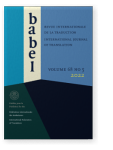Vol. 68:5 (2022) ► pp.697–722
Mind the gap
The nature of machine translation post-editing
Has post-editing changed the nature of translation? Are these tasks two sides of the same coin? These are some of the questions that recent developments in machine translation have brought to translation studies. The quality of the texts rendered by the new neural engines is good enough to challenge the traditional role of the human translator. Some voices even question whether there might be any place left for translators if, in the near future, their role is finally superseded by that of the post-editor. This paper offers a comprehensive view of the many aspects of post-editing with a view to shedding some light on the nature of this task. I first explore how the progress in machine translation has turned post-editing into an essential activity. Then, I present a proposal for a categorization of research areas in post-editing within the framework of translation studies. The central discussion of this paper revolves around three key ideas: (1) the conceptualization of post-editing as more than a simple, fast and inexpensive task; (2) the framing of post-editing as a dynamic process; and (3) the claim that defining quality in machine translation post-editing is not as straightforward as it may seem. The ultimate goal of this paper is to lay the foundations for further discussion into what it is that post-editing means for translation studies.
Article outline
- 1.Introduction
- 2.How machine translation progressed in terms of quality and post-editing became a relevant task
- 3.Machine translation post-editing in translation studies
- 4.Machine translation post-editing is more than a simple, fast and inexpensive task
- 5.Framing machine translation post-editing as a dynamic process
- 6.Quality in machine translation post-editing is a tricky issue
- 7.Concluding remarks
- Notes
-
References
